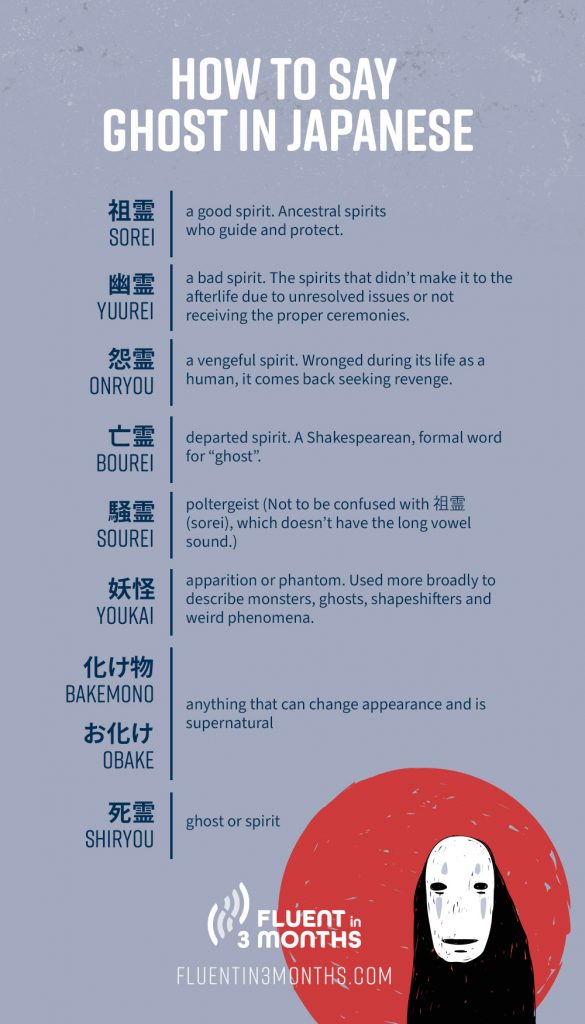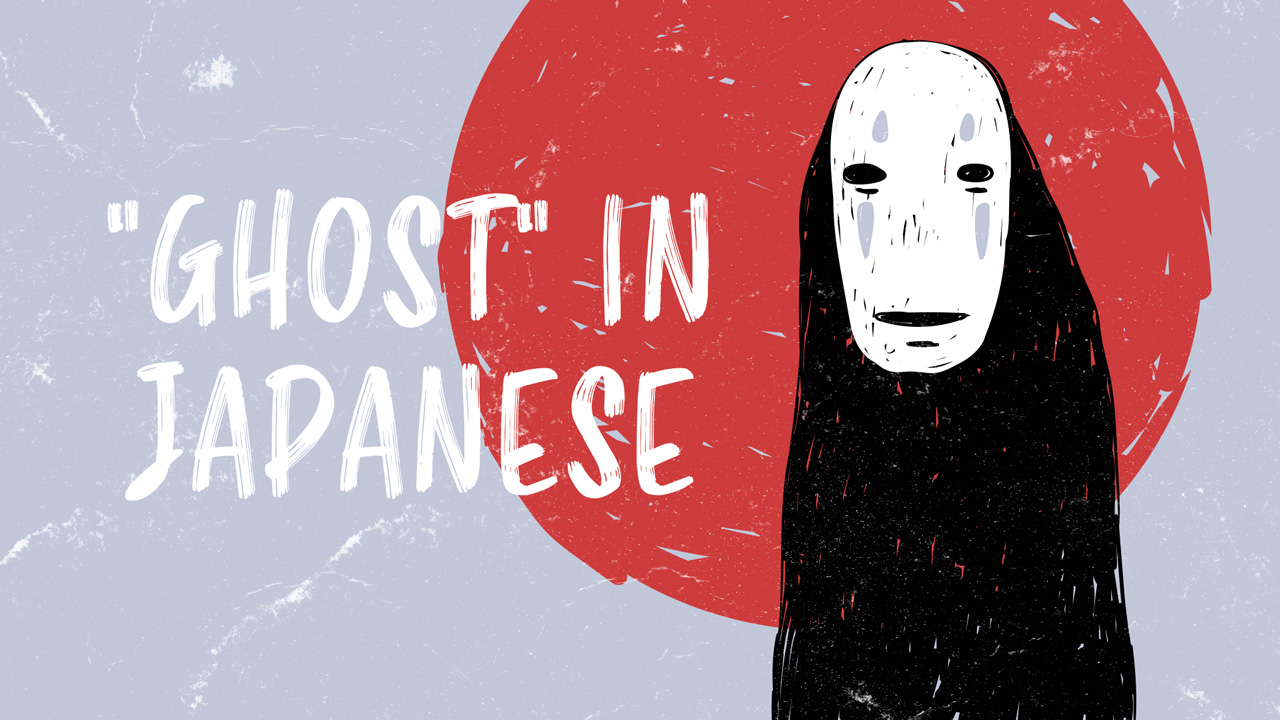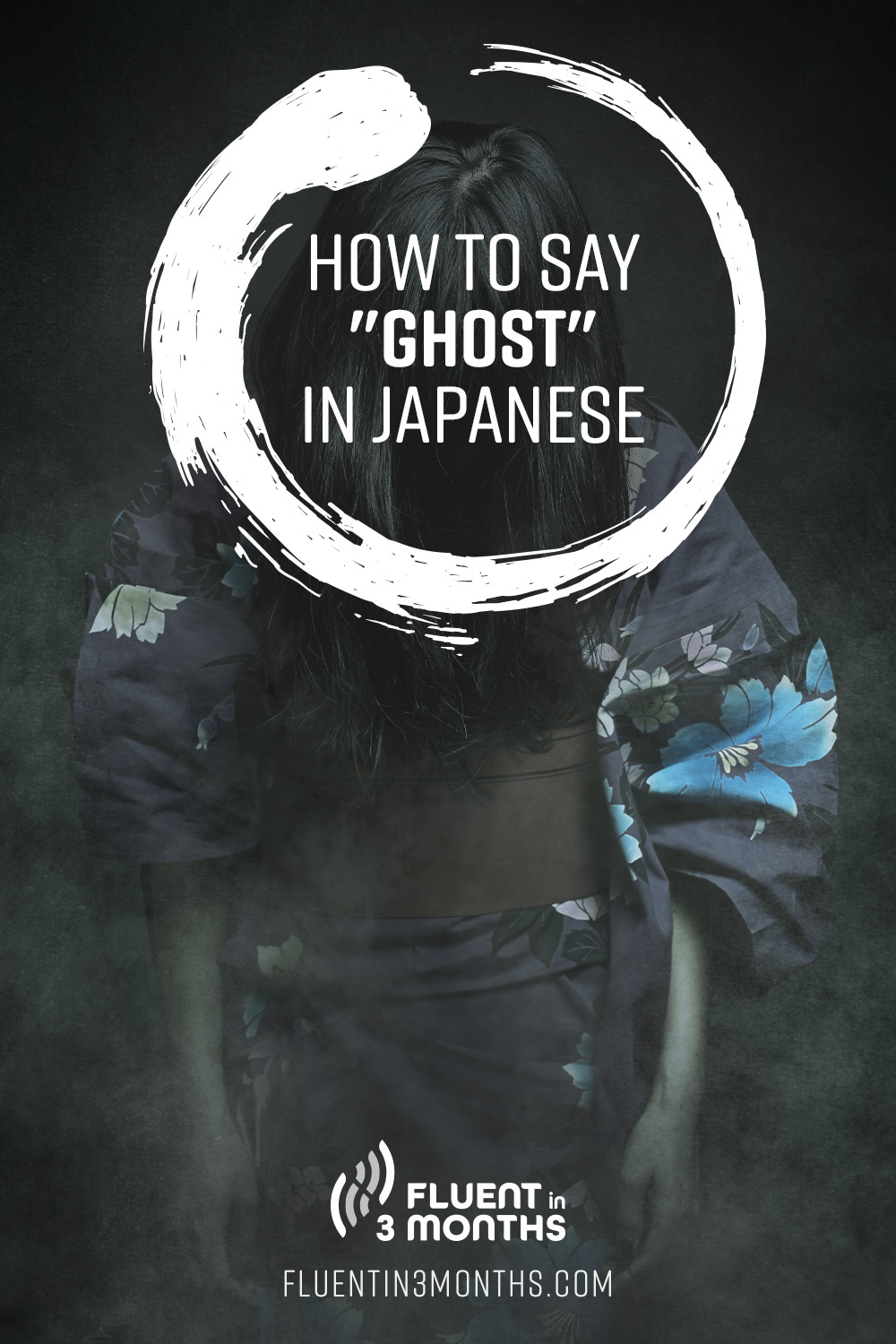How to Say “Ghost” in Japanese: Plus Spooky Japanese Ghost Stories
“Ghost” in Japanese is 幽霊, yuurei. Well, that’s one of the many words for it anyway!
Japan has a love for all things spooky, creepy, haunting, and ghost-like. So, it only makes sense that there’s going to be more than one word for “ghost” in Japanese!
And, really, most languages have different words for things from the afterlife. Spirits, demons, poltergeist, apparition, phantom, wraith… and they all mean somewhat different things.
So if you, too, love ghosts, scary stories, and creepy things – this article is for you!
Table of contents
- How to Say “Ghost” in Japanese
- Spooky Japanese Vocab To Know
- Culture Talk: Significance of Ghosts, Death, and the Afterlife in Japanese
- Japanese Ghost Stories: The Scariest Youkai in Japanese Folklore
- Yotsuya Kaidan: The Famous Story of Haunting Revenge
- Baku: The Nightmare Eater
- Banchou Sarayashiki: The Vengeful Servant
- Zashiki Warashi: Parlor Children
- Shirime: The Ghost with a Butt Eye (I Wish I Was Kidding)
- Kuchisake Onna: The Joker in Female Ghost Form
- Mimi-nashi Houichi: The Famous Haunted Musician
- Yuki Onna: Murderous Snow Spirits
- Japanese Ghost Stories in Media: Must-See Movies and Anime for Horror Fans
- Shiver Down Your Spine from These Japanese Ghost Stories?
How to Say “Ghost” in Japanese
So – the main question. What is “ghost” in Japanese? Japanese ghosts have many words to describe them, so it depends on the type of ghost you’re talking about.
A good spirit is called 祖霊 (sorei). These are your ancestral spirits who will guide and protect you.
But bad spirits are called 幽霊 (yuurei), the spirits that didn’t make it to the afterlife due to unresolved issues or not receiving the proper ceremonies.
There’s also 怨霊 (onryou), or “vengeful spirits.” These spirits are often women and people with little power or influence in life who died wrongfully or hold a lot of hate for things that happened to them. They come back as wraiths, determined to get revenge for what was done to them.
What are Japanese ghost stories called? They’re often referred to as 怪談 (kaidan), which refers to any story that’s strange, mysterious, or spooky.
Japanese horror is borrowed from English: ホラー (hora-).
Here are some other words for “ghost” in Japanese:
- 亡霊, bourei: “Departed spirit” – a Shakespearean, formal word for “ghost”.
- 騒霊, sourei: “Poltergeist” – not to be confused with 祖霊 (sorei), which doesn’t have the long vowel sound.
- 妖怪, youkai: “Apparition” or “phantom”, but used more broadly to describe monsters, ghosts, shapeshifters and weird phenomena.
- 化け物, bakemono, or お化け, obake: “Ghost”, but also “goblin”, “monster”, or “phantom”. Anything that can change appearance and is supernatural.
- 死霊, shiryou: “Ghost” or “spirit”.

Spooky Japanese Vocab To Know
Besides ghosts, you’ll need to know some other related words to talk about or listen to ghost stories.
Here are some to get you started!
Bad Feelings:
- 怖い, kowai: “Scared” or “scary”
- おっかない, okkanai: “Frightening”
- 恐ろしい, osoroshii: “Dreadful”
- 恐怖, kyoufu: “Fear”
- 恐れって, osorette: “Afraid”
- ゾッとする, zotto suru: “To shudder” (from the creeps or fear, a cold chill down your spine)
- ぐろい, guroi: “Gross,” “grotesque”
- 不気味, bukimi: “Spooky”
- 気持ち悪い, kimochi warui: “Bad feeling” or “creepy”
Body Parts:
- 骨, hone: “Bone”
- 骨格, *kokkaku: “Skeleton”
- 血液, ketsueki: “Blood”
- 頭, atama: “Head”
- 首, kubi: “Neck”
- 手, te: “Hand”
- 腕, ude: “Arm”
- 足, ashi: “Leg” and “feet”
- 指, yubi: “Fingers”
- 足の指, ashi no yubi: “Toes”
Creepy Things:
- 怖い話, kowai hanashi: “Scary story”
- 超自然, choushizen: “Supernatural” or “occult”
- 変化, henge: Literally, “change” but refers to shapeshifting beings such as 狐 (kitsune, “foxes”) in Japanese lore
- 怪獣, kaiju: “Monster”, like the most famous Japanese 大怪獣 (daikaiju), Godzilla
- お墓, ohaka: “Grave”
- 魔女, majo: “Witch”
- 吸血鬼, kyuuketsuki: “Vampire”
- 殺し, koroshi: “Murder”
- ゴア, goa, or 流血, ryuuketsu: “Gore” or “bloodshed”
P.S. – Japan does celebrate Halloween! It’s called ハロウィン (harowin)! But it’s different than you might expect. There’s no Trick-or-Treating, but they do have a lot of costume parties!
Culture Talk: Significance of Ghosts, Death, and the Afterlife in Japanese
Japan is largely a Shinto or Buddhist nation, so they believe in different afterlife planes of existence.
In the Shinto afterlife called 黄泉の国 (yominokuni) or the Buddhist afterlife called あの世 (anoyo). There’s also hell, 地獄 (jigoku), but it’s not just one place. It can be many, with different types of punishment.
Interestingly, its believed that the 黄泉の国 (yominokuni) and 地獄 (jigoku) are located in Japan, at locations like Yomotsu Hirasaka in Izumo and Mount Osore in Aomori.
Japan also has a special day to celebrate ancestral spirits. It’s called お盆 (obon), which lasts 3 days and is based on Buddhist traditions. It’s usually celebrated in July or August, based on the region.
Food offerings are made to family memory altars at home and people visit their ancestors’ graves. Floating lanterns are placed in water to help guide the spirits back home.
In Japan, death is a bit more complicated. It’s considered a hard journey to the afterlife, and you have to pass peacefully, leaving nothing unresolved. It’s also up to your family to help care for your soul with certain rituals that help guide you to the afterlife.
And everyone has a certain “moral debt” they owe to their parents and ancestors for giving them life. This debt, called 義務 (gimu), is honored by providing proper ceremonies and rituals after a loved one’s death, and for honoring ancestors with home altars and on Obon.
The Japanese also believe the spirits can return to visit, so ghosts aren’t always bad – sometimes they’re good spirits here to protect or guide. It’s considered a part of life.
Japanese Ghost Stories: The Scariest Youkai in Japanese Folklore
Yotsuya Kaidan: The Famous Story of Haunting Revenge
This is one of the most famous Japanese ghost stories, which originated as a kabuki play. There’s even a shrine: The Oiwa Inari Tamiya Shrine in Yotsuya, Shinjuku.
In a complex plot of love, hate, murder, and revenge, the beautiful Yotsuya Oiwa is married to ronin samurai Tamiya Iemon. But her sister, Oume, who is considered less attractive, also loves Iemon and wants his affection.
Oume then decides to poison her sister via face cream, causing horrific damage to her sister’s beautiful skin. As a result, Iemon wants nothing to do with Oiwa anymore (and does some pretty horrible things in the process).
Oiwa, devastated, accidentally kills herself and comes back as an onryou, a vengeful ghost. In the end, everyone dies and her ex-husband, Iemon, is driven to madness by her haunting.
Baku: The Nightmare Eater
A beast that looks like the Asian tapir, the Baku (獏, baku) are youkai beings that devour nightmares. Like Beetlejuice, you have to call for him three times: “Baku-san, come eat my dream.”
The story goes that a child who wakes from a bad dream and calls for Baku three times will have their nightmare eaten by the beast so it goes away. But, the Baku may also suck up all their good dreams too, leaving them apathetic.
Banchou Sarayashiki: The Vengeful Servant
番町皿屋敷 (banchou sarayashiki, “The Dish Mansion”) tells the story of Okiku, a beautiful servant.
There are a few different versions of the story, but in Japanese folklore, it’s said Okiku worked for Aoyama Tessan, a samurai. He was in love with her, but she didn’t love him and would refuse his advances.
This angered Aoyama. So one day, he plotted to force her to love him. He framed her for losing one of the family’s 10 heirloom plates.
This would’ve normally led to death for the servant, but he promised to forgive her if she would finally agree to be with him. Still, Okiku refused, so Aoyama threw her down a well to her death.
Okiku, knowing she was wronged, came back to haunt him as an onryou. She would count to 9 and then shriek for the 10th plate he claimed she lost.
Zashiki Warashi: Parlor Children
座敷童 (zashiki warashi) are youkai spirits that cause mischief and play pranks on people. They’re said to bring good fortune to those who are visited by them.
This ghost story stems mainly from the Iwate Prefecture. Some say they can only appear to their own family, or only seen by other children.
But if you see one that has a red face and red clothes, the child spirit is about to leave. And as a protector spirit, its absence could mean bad fortune and things to come for the family.
Shirime: The Ghost with a Butt Eye (I Wish I Was Kidding)
This one is absolutely hilarious.
尻目 (shirime, literally: “butt eye”) is a youkai who, at first, looks like a normal human… But then it turns around and has no face.
If that wasn’t shocking enough, this mischievous spirit then drops its clothes, turns around, and flashes you its butthole eyeball.
This youkai is said to just enjoy scaring people, but the fact that this exists is so hilarious. Japanese people really like this type of creepy, gross humor.
Kuchisake Onna: The Joker in Female Ghost Form
口裂け女 (kuchisake onna, “Slit-Mouthed Woman”) is another onryou who wanders around at night looking for revenge. It’s said she was brutally attacked and had her mouth slit from ear to ear.
Now, a vengeful ghost, she goes around with her mouth covered by a mask, carrying a sharp item like a knife or scissors. If she comes up to you, you’re pretty much doomed.
She’ll ask, “私、きれい?” (Watashi, kirei?, “Am I pretty?”). If you say no, she kills you on the spot. If you say yes, she’ll remove her mask and ask again or say これでも? (kore demo, “Even this?”).
If you say no or show fear, you’re dead. If you say yes, she’ll give you her same ear-to-ear smile.
Brutal? Absolutely. But if you ever encounter Kuchisake Onna, then you need to be prepared. You can tell her she’s “average”, throw money or candy at her, or, supposedly, say the word “pomade” three times.
Mimi-nashi Houichi: The Famous Haunted Musician
耳なし芳一 (mimi-nashi houichi, “Houichi the Earless”) is another famous Japanese ghost story. The tale goes that Houichi was a blind musician who played the Japanese lute called a biwa.
Houichi was very poor, although very beloved for his musical talent. He lived with his friend, who was a priest, at a temple.
One day, Houichi met with a traveling samurai who asked him to play for his daimyou lord. Houichi obliged, and they loved his performance so much, they asked him to come back.
But the priest was suspicious that his friend kept disappearing at night. So he sent servants after Houichi, only to find him playing in a cemetery.
His friend realized he was being tricked by ghosts, so he painted protective kanji all over Houichi and told him to not answer the ghost’s calls. But he forgot to write the protective spell on Houichi’s ears.
So when the ghost came, he could only see Houichi’s ears. He ripped them off in anger and left. But Houichi survived and was freed from the ghost’s grasps, and continued to play music.
Yuki Onna: Murderous Snow Spirits
It’s said that 雪女 (yuki onna, “Snow Woman”) are other-worldly beautiful women with snow-white skin and long black hair. There are many different stories, but the yuki onna target victims to steal their life energy.
Some say the yuki onna lure men to their deaths by freezing them in the snow. Others say they suck the life out of them. Some say that yuki onna is one woman, who was murdered in the snow and now does the same to others.
But, some legends claim there have been men who fell in love and married a yuki onna, and they lived happily.
Japanese Ghost Stories in Media: Must-See Movies and Anime for Horror Fans
You probably already know that Ju-On (The Grudge) and The Ring are two of the most famous Japanese ghost stories in cinema. But if you’re looking for more ghost stories and horror movies, here are some suggestions in media:
Gakkou no Kaidan: Ghost Stories (Japanese TV Series)
学校の怪談 (gakkou no kaidan, “Ghosts at School”) is a manga and anime movie series. It’s about Satsuki, a young girl who moves to a haunted town after her mother passed away.
It’s discovered that the old abandoned school is haunted, along with the town, and that Satsuki’s mother was the one who sealed the ghosts away. Now, Satsuki must use her mother’s book of notes to learn to seal the spirits and demons away again.
Yamishibai: Japanese Ghost Stories
闇芝居 (yamishibai, “Dark Play”), also called Yamishibai: Theater of Darkness, is a Japanese anime series. It’s a collection of Japanese ghost stories, myths, legends, and folklore.
In the episode, a man in a yellow mask (creepy) rolls up to a kid’s playground to tell them ghost stories (even creepier). If you want to know more ghost stories, this is a good one to watch!
Dark Water
仄暗い水の底から (honogurai mizu no soko kara, “From the Depths of Dark Water”) is a horror classic. (But just the Japanese version, not the American one.)
A divorced mom, Yoshimi, has to move into a rundown apartment with her daughter, Ikuko. But the apartment complex is haunted. Strange things begin to happen at her apartment, which has a mysterious leak from upstairs.
Pulse
回路 (kairo, “Circuit”), is a cult classic horror film which was also remade by Hollywood.
A ghost invades the world through the internet, resulting in tons of people disappearing. As fewer and fewer people remain, they must find a way to survive.
Shiver Down Your Spine from These Japanese Ghost Stories?
ゾッとした (zotto shita) – Shiver down your spine? No worries, we’re done for today! Call the Baku if you need him tonight. 😉
Ready to learn more about Japanese culture? Keep learning with these articles:




Social